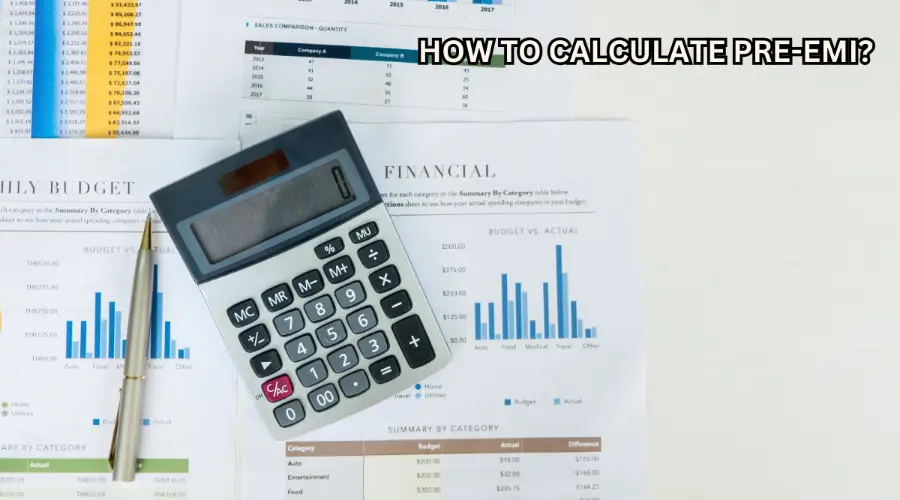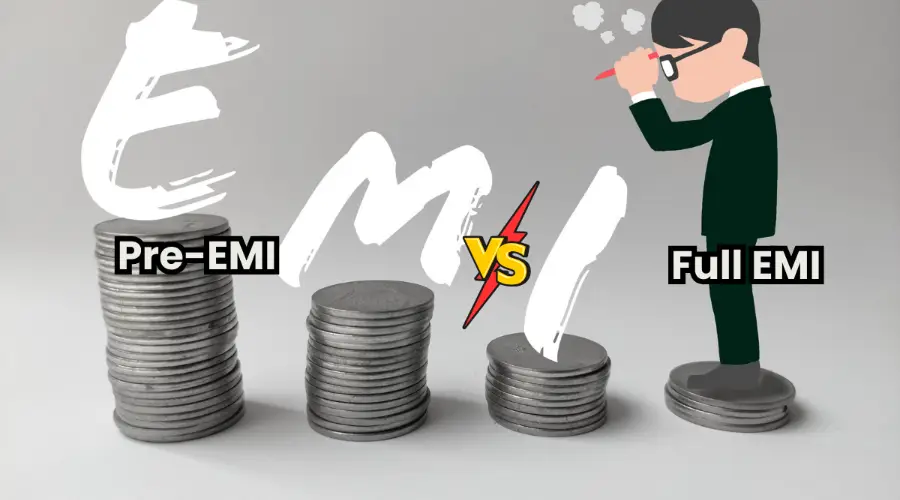The cost of real estate has been escalating significantly. Nowadays, buying a home outright is challenging. Home loans are your only option for financing your house. It’s crucial to pick a lender with low home loan interest rates.
There are several options for house loan repayment, but you should be prudent enough to select between pre- and full EMI options. Having the right information in this area will help you manage your finances while your house is being built. Learn more about the meanings of pre-EMI and full EMI by reading on.
What Exactly is Pre-EMI?
Pre-EMI is the term used to describe the monthly interest payments made on a home loan while your house is being built. Because they only cover the interest and not the principal, these payments, which are made while the property is being built, are less than the full EMI instalments.
The pre-EMI phase, not part of the home loan tenure, ends when your house is built. This repayment plan is primarily intended for people with low incomes.
How Pre-EMI Works?
Let’s first clarify the working method of pre-EMI repayment:
Borrowers of home loans have the option of pre-EMI repayment while the property is still under construction. With this approach, you merely pay the interest portion of the total amount that the bank disburses for your home loan. Principal repayment begins once construction is complete and the property is ready for occupancy. Because the principal is not being repaid, pre-EMI instalments are often less than full EMI payments.
How to Calculate Pre-EMI?

You can use the following formula to determine your pre-EMI amount:
Loan Amount + Total EMI Amount = Total Repayment
Calculation of Pre-EMI with an Example
This example will give you a better understanding of pre-EMI:
Assume you want to buy an under-construction property and take out a home loan of Rs 50 lakh for 20 years at an interest rate of 8.5% p.a. You might choose to make pre-EMI payments throughout the two years that the construction will be finished. The pre-EMI payment stops when the property is finished, and the usual EMI repayment period starts. The pre-EMI period would be two years, plus the loan tenor of twenty years, for a total house loan length of twenty-two years.
If you choose a 5 lakh disbursement tranche for a Rs 50 lakh house loan, your pre-EMI will be Rs. 5 lakhs x 8.5%/12 = Rs. 3,542. If you receive an additional payment of Rs 10 lakhs after six months, your pre-EMI will increase to Rs 10,625 (Rs 15 lakhs x 8.5%/12). In the case of pre-EMI, it should be mentioned that the full amount paid will be used for interest payments rather than principal repayment.
Benefits of Pre-EMI
- Paying rent alongside your home loan can make pre-EMI an excellent option.
- Because pre-EMI payments are smaller than full-EMI payments, you can better manage your cash flow and use the money saved to make a larger down payment or invest in other projects or short-term income generation.
- Select a pre-EMI payment plan if you intend to sell the property when construction is complete.
- If you don’t have enough financial resources, you can immediately access a loan.
Disadvantages of Pre-EMI
- The longer loan term is one of the major disadvantages of pre-EMI because you are not making principal payments during the construction phase.
- The interest component continues to compound throughout the pre-EMI phase, impacting the cost-effectiveness of your loan.
- Delaying the repayment of the principal amount borrowed is what pre-EMI entails, and you won’t be accumulating property equity as quickly as you would with a regular EMI.
- Your ownership of the property is still restricted until you begin to repay the principal, and your property may not be as easily utilised as it may be in the event of unexpected incidents.
Pre-EMI vs. Full EMI: Which Should You Choose?

The decision between pre-EMI and full EMI payments is based on your goals, risk tolerance, and financial status. In the following situations, one choice might be better than the other:
| S. No. | Factors | Pre-EMI | Full EMI |
| 1 | Initial EMI Amount | Lower, as it covers only the interest component. | Higher, as it includes both interest and principal repayments. |
| 2 | Total Interest Payment | Higher in the long run because no principal repayment occurs during the initial phase, increasing interest costs. | Lower overall due to immediate principal repayment, reducing the interest burden. |
| 3 | Loan Tenure | Longer, as principal repayment starts later. | Shorter, as both principal and interest repayment begin immediately. |
| 4 | Cash Flow | Better short-term cash flow due to lower initial EMIs, beneficial during property construction. | Faster repayment is made possible by increased initial financial strain brought on by larger EMI instalments. |
| 5 | Total Cost of Property | Higher because of extended loan tenure and increased interest payments. | Lower due to faster principal repayment and reduced interest payments. |
| 6 | Tax Benefits | Tax benefits on the interest component under Section 24(b), but no benefits on principal repayment during construction. | Tax benefits on both interest (Section 24(b)) and principal (Section 80C), making it more tax-efficient. |
| 7 | Risk Factors | Higher risk if project construction gets delayed, increasing Pre-EMI costs. | Lower risk as repayment starts immediately, less affected by construction delays. |
Tax Implications of Pre-EMI
During the property’s construction, you are not eligible for a tax deduction. However, interest payments (under the pre-EMI or full EMI approach) will be totaled and eligible for a tax deduction in five equal instalments once the property is possessed. During the next five fiscal years, you can deduct these instalments under Section 24.
The maximum tax benefit under Section 80C for principal repayment is INR 1.5 lakh per fiscal year. For self-occupied residential properties, the tax benefit for paying the interest amount under Section 24 is capped at INR 2 lakh. A property that is rented or leased, however, has no upper limit.
Tips to Manage Pre-EMI Effectively
- Make sure you have a clear budget to handle both pre-EMI and other expenses.
- Use the money saved from pre-EMI to invest in something that can earn you more.
- Keep an eye on how the construction is progressing so you’re ready when full EMI starts.
- Set aside some money for emergencies in case something unexpected happens.
- Talk to your bank about switching to full EMI or getting better terms if needed.
- If interest rates drop or your finances improve, think about refinancing your loan.
- Start planning for the higher full EMI payments by saving up and adjusting your budget.
Conclusion
Pre-EMI is typically used by borrowers who do not want to put a lot of strain on their finances during the first few years of building a home but who either seek out another investment opportunity that offers exponential returns that can offset both the pre-EMI interest and the full-EMI loan repayment amount while still yielding high returns, or who anticipate a significant change in circumstances that will allow them to pay full EMI after the pre-EMI period ends. For many of us, becoming homeowners has always been a dream, and the availability of pre-EMI loans makes this dream possible.
FAQs
The loan tenure will get extended if construction is delayed in pre-EMI.
It is an option given to you at the initial stage of constructing your house; after completion of the project, you are said to pay the full EMI amount.
Yes, you can convert your pre-EMI payment into regular instalments.

